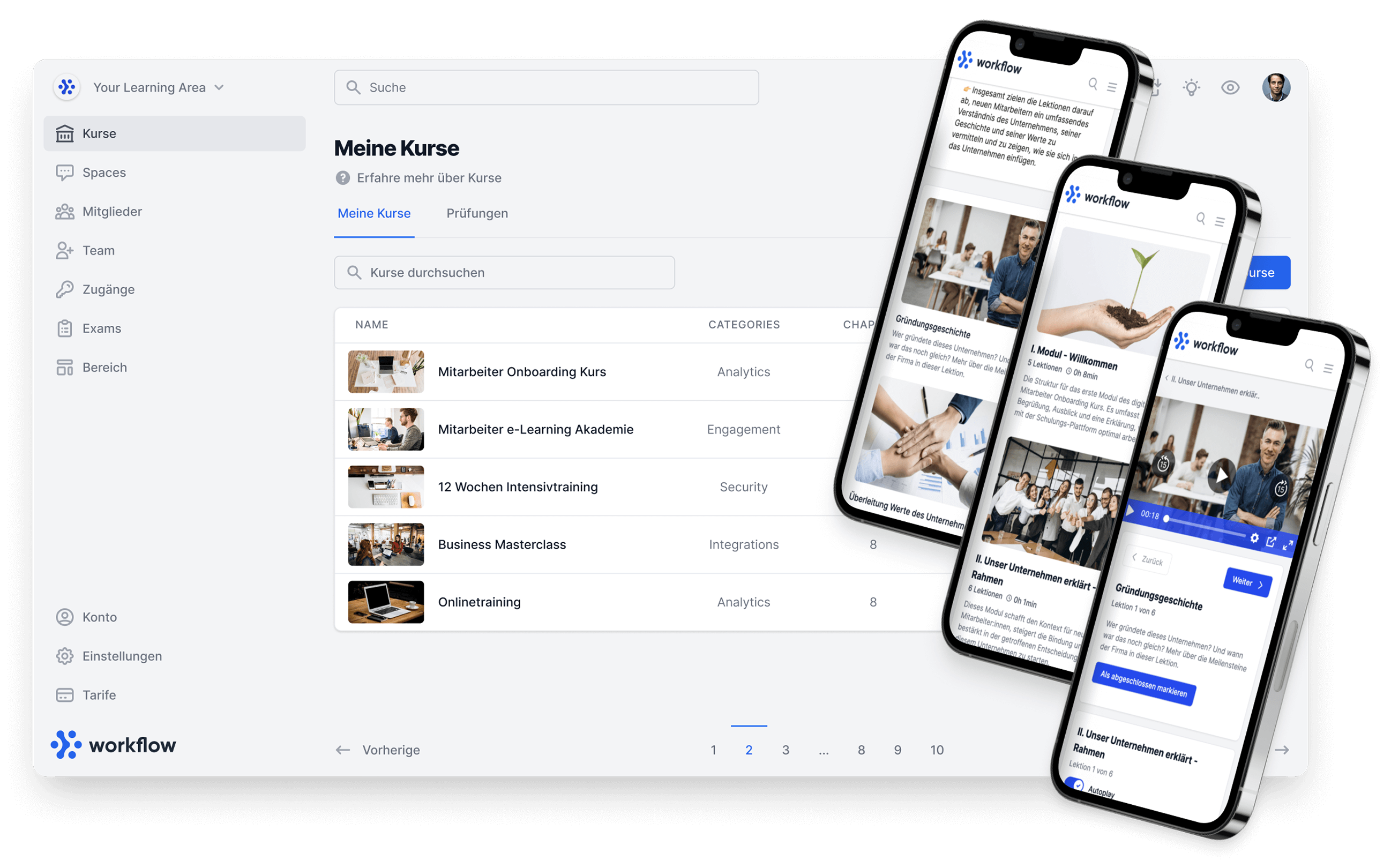Your path to your own online course
Online courses: Who hasn't heard of them? What sounds like dull learning in front of a screen is actually an important tool for focused knowledge transfer. Whether coaches, online sales courses or e-learning for companies - these days, online courses are omnipresent in every industry. But:
Not all online courses are the same, as the differences in quality are sometimes enormous.
Are you a coach or entrepreneur and want to know how to create and sell online courses ? In our complete guide, we explain step by step how to create an online course with added value. Sit back and find out more.
What is an online course anyway?
It's simple: an online course is the modern version of the popular face-to-face course and takes place exclusively online. It helps you personally or professionally and provides you with valuable knowledge on a specific topic.
Basically, an online course consists of learning units that build on each other logically. In the courses, you can work with different media such as videos, images, audio files, texts and hyperlinks. If you mix these media, your course remains interesting and your clients can follow you more easily. The learning control can be integrated into a course in the form of tests or worksheets.
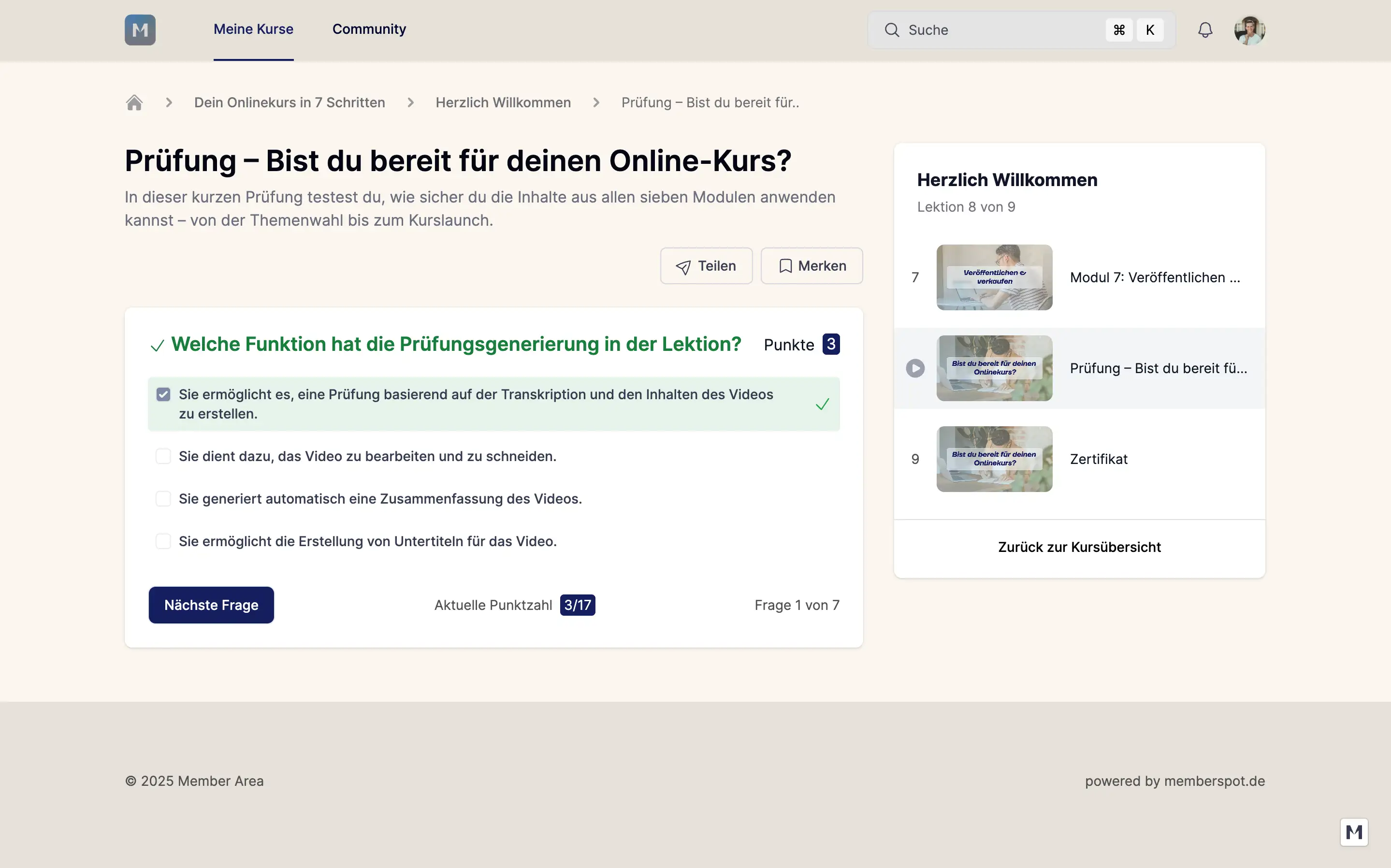
In contrast to the face-to-face courses, the online version has the advantage that participation is possible from anywhere. This means that all participants remain flexible, independent of location and can continue their education remotely alongside work and family. This is convenient and increases the success rate of learners. Participation is also uncomplicated, as all you usually need is internet access and a PC, laptop or smartphone.
The advantages for the creator are also obvious! The knowledge transfer is scalable. You no longer exchange time for money.
What types of online courses are there?
As a coach, you probably have different intentions with your online course than a manager of a small business. You can distinguish between these three types of online courses:
Online course as a digital product
Do you have a wealth of knowledge and experience on a specific topic and want to share your expertise with others? Then launch your online course as a digital product and earn money with it. Skillshare, Open Education Database and Udemy are leading the way: The sale of online courses is a globally sought-after and growing market. To successfully launch your online course on the market, it is important that you:
- You have a topic
- Know your target group
- Decide on an online course platform (such as Memberspot 😉)
- The opportunity to reach your target group (keyword: marketing funnel)
- Has an account with a payment provider (Stripe, Hotmart, CopeCart, Digistore24, PayPal, Mollie, GoCardless, affilicon)

If you have some offline training, you can easily implement it online. With Memberspot, you have the advantage of being able to upload your videos directly without having to resort to platforms such as Vimeo or YouTube. The best thing about it: you have unlimited video storage, the content is protected against copying and is stored on EU servers.
If you are still unsure about the topic, we will give you a little help. These themes always work:
1. online courses for specific hobbies
Painting, writing, cooking, baking - there's almost no hobby for which you can't create explanatory videos. Are you talented at singing? Then create online courses about singing and launch them on the market.
2. online courses for fitness and sport
Online fitness classes at home are ideal for anyone who doesn't want to go to the gym or get out into the fresh air. Between home office and leisure time, even the most stubborn couch potatoes have the opportunity to keep fit. Yoga, gymnastics, martial arts or even dance - anything is possible.
3. online courses for personal development
In times of self-optimization and the like, the market for online courses for personal development cannot be big enough. Topics such as attention training and time management are more relevant than ever.
Create online course for employee training and onboarding
Online courses are a great help when training new employees to explain the processes in your company or to make new processes understandable. With the help of online courses, they can familiarize themselves independently and receive ongoing training and always stay up to date.
If you want to create explanatory videos, you can convey knowledge and skills flexibly in this way; from onboarding to mentoring. Functions such as "Member Reporting" in Memberspot make it easy to evaluate the learning progress of all participants.
E-learning makes sense for companies in these areas:
- Onboarding: As part of the induction process, you can introduce your new employees to work processes, software and structures in an online course. In addition to the courses, it is best to provide them with checklists as PDF downloads.
- Further training: Inform all employees about the latest news in specific areas - for example, new data protection regulations or hygiene regulations in the company.
- Soft skills: With online courses on soft skills, you can offer your employees certain additional qualifications.
- Mentoring: One of your experienced colleagues trains an employee in new areas of work with the help of online courses.
There are no limits to the creativity of your online training courses. You can use videos, audio files, PDFs, texts, quizzes or images to explain the content to your employees. This ensures that everyone in the company is on the same level. Employee training courses as online courses are also valuable for giving your employees a different view of the company.
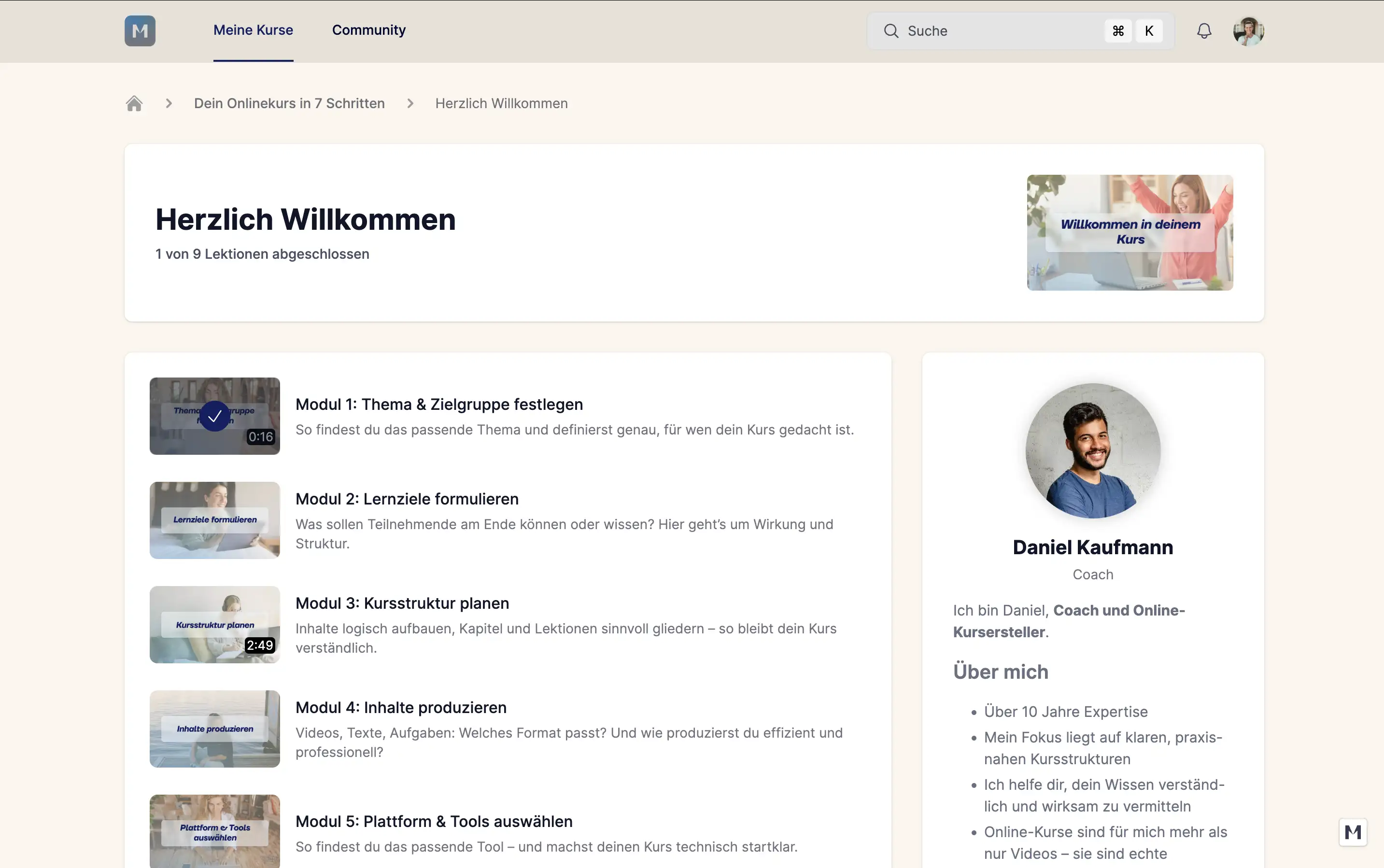
If the company grows, you have to pick up all the people. Online courses that convey the "big picture" help new colleagues to see the big picture. This increases morale and understanding.
Create and sell online courses
In the member area, your customers can access your online courses, your Online Academy, using a user name and password. This member area is available to customers either free of charge or for a one-off or monthly fee.
If you want to create your own member area, this is particularly worthwhile if you have already built up a community and offer exclusive content. The advantages: It is easy to monetize your member area and your coaching content is only offered in a protected space. If a coaching participant is unable to take part in a Zoom live call, they can watch the recording later at their convenience, even at 1.5x speed. (or faster 🚀)
Tip: With Memberspot, you can create a member area in just a few clicks and get started right away. With us, all your data is copy-protected with digital rights management (DRM) and stored on secure servers in the EU.
Why should you create and sell online courses?
Knowledge is increasingly being imparted online these days. Basically, anyone can acquire the knowledge they are looking for in the digital world. However, not all sources are trustworthy. The demand for professional and reputable knowledge transfer services is correspondingly high. In other words, no matter what niche you serve as an expert, there are plenty of people in the digital world who will listen if you want to teach them something.
You can reach many more people with online courses than in analog life. This increases your impact. In addition, both you and your customers can work more flexibly, as you are not tied to a specific place or time. Online courses are also a useful addition to your portfolio and offer you a good opportunity to earn a passive income.
The advantages of online courses at a glance:
- Flexible learning for your community
- Simple knowledge transfer
- 100% remote- Short-term planning
- Tailor-made content
- You reach more people
- Lower budget than for face-to-face courses
- Create creative explainer videos
- Contents can be easily updated
- Test options (for example through multiple choice)
- Various media possible
- Evaluation of learning progress
- Earnings from sales
If you want to create your own online course, no one will tell you what the topic, look or structure should be. You have complete freedom.

Online course, webinar, live online seminar and online workshop - what's the difference?
There is a lot going on in the field of online knowledge transfer. Online courses, webinars and online workshops are often used interchangeably - but they are very different. It is important to differentiate between the individual online offerings so that you and your customers know exactly what you can expect from the learning content. We give you a brief overview.
1st webinar
In contrast to an online course, a webinar is a communicative online event that is based on a seminar. Communication between participants and speakers usually takes place via chat. Webinars are very structured and rarely last longer than an hour.
The difference to the online course:
- Live communication via chat for participants
- Between 30 and 60 minutes long
Webinars are ideal if you have a one to many event or if learners want to remain anonymous.
2nd live online seminar
A live online seminar is a type of extended webinar. The participants are connected via audio and video and can therefore talk to each other in the traditional way. The live online seminar thrives on exchange and interaction - just like a traditional face-to-face seminar. Online seminars generally do not follow such a fixed structure as webinars and last longer.
The difference to the online course:
- Live communication via audio and/or video
- Direct exchange between the participants
- Require less structure
Unfortunately, not all participants get to speak at well-attended webinars.
3. online workshop / online congresses
Workshops are very practice-oriented. Participants interact with each other via audio and video and work independently or in teams on a task. The role of the presenter is as follows: He introduces the workshop, gives instructions on the tasks and assists the participants with input and support. Live demonstrations and question and answer sessions are also part of online workshops.
The difference to the online course:
- Live communication via audio and/or video
- Practice-oriented including live demonstrations and tasks
- Working in teams
Whether webinar, live online seminar, online congress or online workshop: Memberspot customers use all types of content every day and save it in their member area and make it available to their members.
Planning and structuring the course content
Preparation is everything. What sounds like a cliché is actually true in most cases. Want to create your own online course? Even then, almost nothing works without solid preparation. Preparation includes everything you need to start producing and marketing your course. This includes
- The target group analysis
- The topic of the course
- The aim of the course
- The outline of the course
1. analyze your target group
Anyone offering a product should know who they are offering it to. Otherwise it won't sell. So find an answer to the question:
Who am I creating this online course for?
An example: You are a successful personal trainer and earn a solid four-figure sum every month from your personal training sessions. Now you want to pass on your experience so that others can benefit from it. In this case, your target group includes busy people with a good income, people who want to get fitter, because everyone else is unlikely to be interested in your experience.
If you are not able to define yourself so well with your target group, then put yourself in their shoes. The more specialized you are, the more this person will see your offer as the best. Imagine what they want and what they expect from your course and think about what concrete solution you offer for their problems.
2. choose the right topic for your online course
If you haven't found it yet, it's time to go and find it: your niche. Basically, your niche is exactly where your target group is. If you know your target group, you also know your topic. Now it's time to gather relevant information, because research is an important part of your course topic. Even if you are an expert in your field, you can't avoid research.
First collect everything you can find on the topic and then sort the content according to how relevant it is for your target group.
3. define the price target
Before you go any further into the topic, you should first think about what the learning objective of your online course is. How will your customers benefit from participating? What should they be able to do once they have successfully completed the course? Is there a certificate or diploma? If you can answer these questions, it will be easier for you to prepare the content in a focused way and leave out what is not useful. What's more, the learning outcome of your course is also your sales argument. Formulate it as precisely as possible.
4. outline and structure your online course
The individual units of an online course build on each other logically. So divide your topic into categories and subcategories to create a sensible structure. Tools such as the free project management solution Trello help you visualize and plan your content. Simply register with your email and get started. Also make yourself clear:
- How many units your course should have
- How long the participants should need to work through the units
- Which media you would like to use
- How deep you want to go into the topic
- Whether you would like to create a member area
If your course is long, it is a good idea to divide it into chunks and modules. Otherwise, you may not achieve learning success. E-learning courses with between 25 and 100 individual learning units are not uncommon, especially in e-learning for companies. However, in such cases, each learning unit is usually a maximum of 5 minutes long.
The success of your online course depends not only on the length of the learning units, but also on the media you use. Courses that only consist of text or videos run the risk of participants losing motivation. A mixture of short texts, videos, images, statistics and exercises will therefore serve you well. This also ensures that you reach different types of learners, as some learn better visually and others through writing or listening.
You score points with these media:
Video
With video, you have two options: Either you put yourself in front of the camera and convey your content with the help of PowerPoint or PDFs - or you shoot clear learning videos without a direct camera presence. A mixture is also possible: record yourself and at the same time show practical examples on your PC using screen recordings. Certain processes or software can be explained easily and clearly with screen recordings.
Audio files
You should only use audio files if you have clear pronunciation, otherwise it will be difficult to follow you. The right equipment and a quiet environment are also important. You can combine audio files with screen recordings, PowerPoint presentations and PDFs. However, mediations can be created particularly well as audio files.
Tip:
With Memberspot, you don't have to create a video with a still image to get audio files directly into the course playlist. Simply upload the audio file.
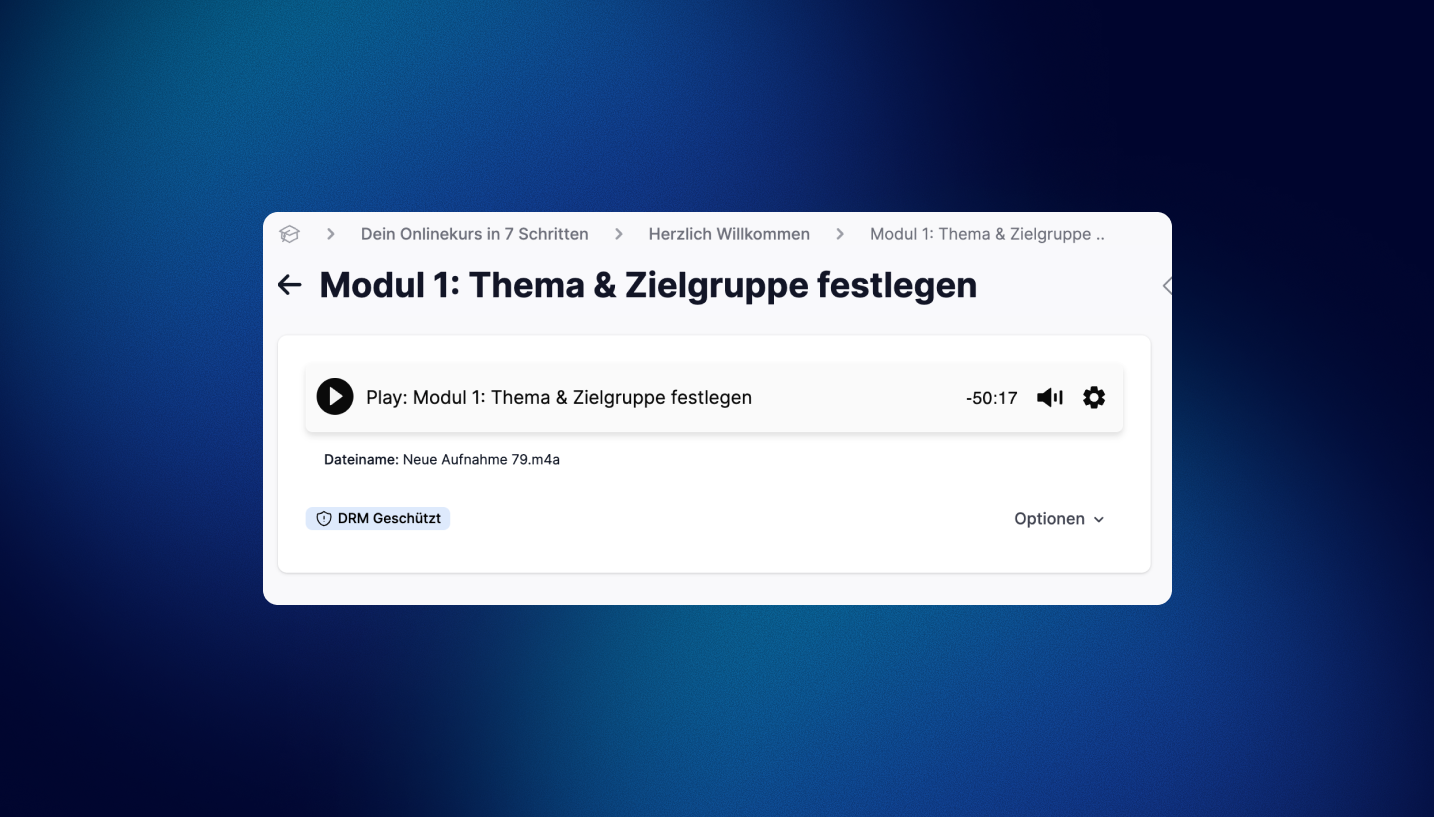
Text and image
Your content can also be communicated effectively with text. Work with different formats, colors, quotations and font sizes to increase readability. Images and diagrams enhance the overall picture and can also clarify your message. Texts are suitable for you if you don't have much experience with video production yet, but want to create and sell online courses quickly. Liven up your course with checklists, tests, summaries and exercises and your participants are guaranteed to stay tuned.
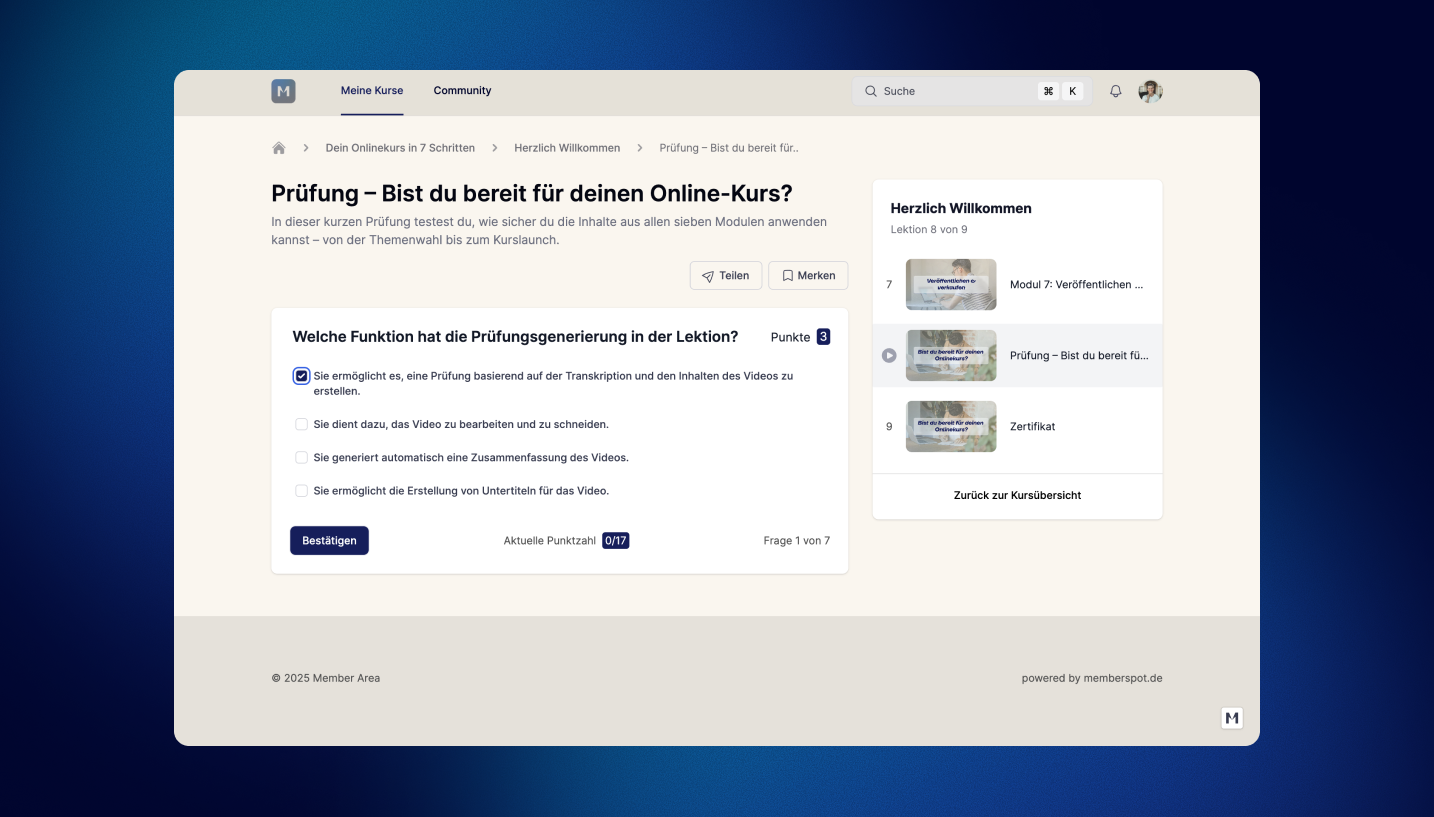
Tip: At this point, you should also select the platform you want to use to create your online course. You can find out more about this below.
5. structure the content
So, most of the groundwork has been done - now it's time for the details. You probably remember what follows from your studies or school:
- Introduction
- Main part
- Conclusion
Yes, a good online course also follows this pattern. When structuring the course, you will probably have already intuitively divided the content according to this method. If not, it's high time you did.
Start with a nice welcome in the introduction and prepare the participants for what to expect in the course. A brief overview is never a bad idea. In the main part, you should arrange the learning units in such a way that they start simply and only become more complex as they progress. At the beginning, teach the participants all the basics they will need for the rest of the course. Once they have understood them, you can increase the difficulty. The last learning units give you space to summarize what they have learned and show them what they have achieved.
Once you have included all the content in the introduction, main body and conclusion, it is best to give it to someone outside your field to read. This will give you direct feedback and help you to see where you need to go back to the drawing board.
Also important: the production plan
Great, you want to create an online course! But there's a big gap between wanting to and doing. The best way to close this gap is with a detailed production plan. In the plan, you record the days on which you want to produce the content for your course, including the duration of production and daily targets. Weekly targets and a deadline provide you with additional motivation and give you a framework within which you should complete the online course.
Producing your videos and content - how to create a good online course
After all the preparation, you can now finally start producing your content. You probably know how to create PowerPoint presentations yourself. PowerPoint offers you so many different templates that you can simply pick one and add your own personal touch.
Video production is a completely different story, as many people come into contact with it for the first time when producing their online course. But don't worry: there are numerous free tools that make video production easier for you.
With Loom, for example, you can record and share your videos effortlessly. This popular tool is available for Mac, Windows and iOS. You can create checklists and attractive thumbnails super quickly with Canva. You can also easily create infographics and certificates. Simply register with Canva for free and choose the template that suits you best from the numerous templates.
Create an online course: What you should consider for camera, sound and light
If you opt for high-quality video content, you're probably asking yourself: "What equipment do I need?" And rightly so. You can get cameras, lighting and microphones for less than 100 euros, but there are no upper price limits. The good news: good doesn't have to be expensive. We'll show you what equipment you can use to achieve great results.
If you would like to learn more about this topic, take a look at this article: Better audio & video quality in online courses and meetings?
1. the camera
No video without a camera - right? You don't have to dig deep into your wallet for good video recordings, as most smartphones can now record video in Full HD or 4K. You can get even better pictures with a video camera that focuses entirely on videos. With the Sony ZV-1 vlog camera, you get a device that offers you high-resolution images in Full HD and 4K for a price of around 699 euros and also comes with an integrated microphone. Also recommended: the Canon EOS M50 MK II system camera for 759 euros.
If you like convenience, then webcams are the right choice for you. Although they usually have a lower resolution than video cameras, they are cheaper and you can connect them directly to your PC and stream live. The Logitech C920s, for example, offers you solid Full HD quality for around 63 euros.
Tip: Your camera should always be at eye level, otherwise your hairline or the tip of your nose will be the star of your videos.
2. the sound
With the exception of a few video cameras - such as the Sony ZV-1 - most video cameras are not known for their outstanding sound quality. The sound is even more important than the picture. Why? Quite simply, poor sound quality makes you look amateurish and people are less likely to buy your expertise.
For professional sound recordings, you should therefore opt for sensible equipment. Directional microphones are usually the first choice. These microphones are simply placed on top of the camera and record the sound from the same direction as the image. Top directional microphones include the Rode VideoMic Pro+ or the Sennheiser MKE 600, both of which are available for less than 300 euros.
If you are in motion during your video recordings, it is best to use a clip-on microphone. You can easily attach it to your shirt or shirt. The advantage is obvious: the distance to your mouth is always the same, so the sound quality remains at the same level. Clip-on microphones such as the RODE SmartLav + are available for just over 50 euros.
3. the lighting
If you're shooting indoors, you need good lighting. Otherwise, you're literally presenting yourself in a bad light - and you don't want that, do you? You can save money by shooting your videos in well-lit rooms in daylight. In this case, the light should always come at an angle from the front, otherwise there is a risk of overexposure.
However, if your schedule doesn't allow for natural light, the only option is artificial lighting. With softboxes such as the Elinchrom Rotalux for around 235 euros, you can create soft and natural lighting. But LED spotlights, mood lighting or a simple desk lamp will also let you shine in the right light. Simply point them at a white wall to create a light that fills the room.
The type of lighting that suits you also depends on the nature of your business. Example: In mindfulness coaching, lamps with beautiful color effects are often used to create a relaxing atmosphere.
Ultimately, however, anything that looks professional and you like is allowed.
4. the background
Chaos, disorder and a wall full of colorful curtains? Better not. Keep the background in your videos understated. A white wall looks more serious than a double bed. Use lamps, plants, books, awards or a sign with your company name.
Find the right platform
Today's possibilities make it easy for you to create and sell online courses. Programming? You don't need to know. There are dozens of platforms that can do this for you and also help you in other areas - such as email marketing. Memberspot is one of them.
Memberspot focuses entirely on the creation of your high-quality online courses. We do away with functions such as landing page builders and instead offer you blazing-fast performance in the backend and frontend. You can also create a member area with us and design your own mobile app to increase your branding. In contrast to international platform giants such as the online course marketplace Udemy, with Memberspot you don't have to worry about your course being marketed alongside those of market competitors. By connecting to tools such as payment providers, you can also easily manage your sales.
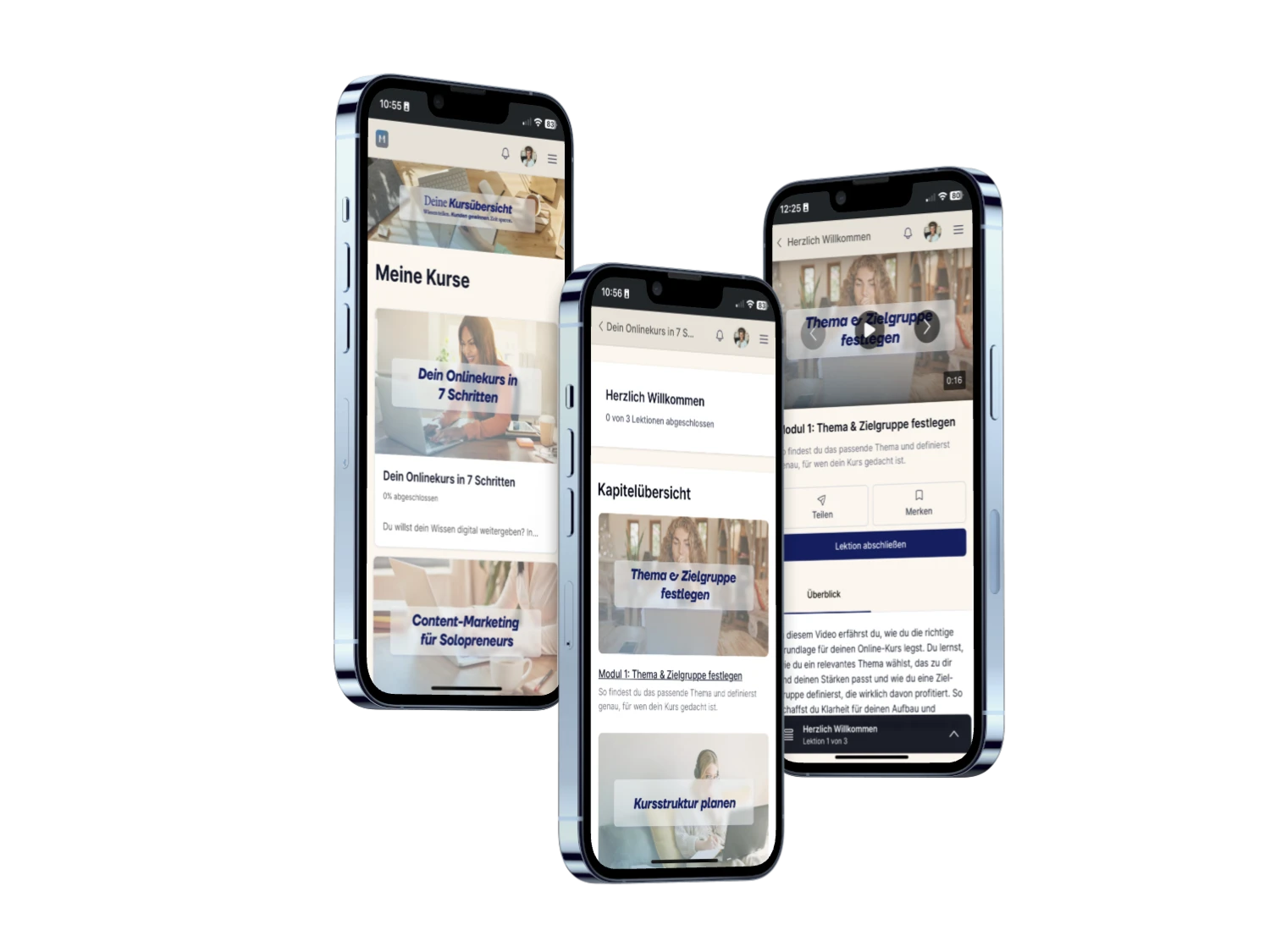
Udemy, on the other hand, is a payment service provider, marketplace and course platform all in one. Another major advantage of the American platform is its image. You can use this to increase your reach and sell your courses effectively. Even as a newcomer, you have a chance to make it big on Udemy. However, you cannot set the prices for your courses yourself and Udemy keeps a share of the profits for itself.
The New Kajab platform also offers you a practical all-in-one solution. Online courses, landing pages, email marketing and your own website all run on the same system. You can process payments with Stripe or another payment provider. New Kajab costs USD 149 for monthly payment in the smallest package (as of 05/2022) and is based in the USA.
Either way, there are numerous providers. Before you decide on a platform, you should inform yourself about these 4 points:
1st location
The location of the provider plays an important role when it comes to data protection. For providers with foreign servers, you need to protect yourself legally in order to meet the requirements of the GDPR. To save yourself the stress at the start of your online course career, you can opt for platforms with servers in Germany or the EU.
2. range of functions
More equals better? Not necessarily. Very few platforms provide you with all the tools you need, because the devil is in the detail. And that doesn't have to be the case as long as they offer you the option of connecting external tools. However, if you prefer to have everything in one system, all-in-one platforms are exactly what you need.
3. costs
Subscription with monthly basic fee, profit sharing, hybrid - choose a platform that works with transparent pricing models. This gives you a complete overview of your finances at all times.
4th language
If you are fluent in English, the world of online course platforms is open to you. If this is not the case, you should opt for a German-language platform. Otherwise, you may get lost in the backend for days and still not understand what you were doing there. Customer support is also not always offered in German.
Are you unhappy with your current provider? Here's the solution: With our free migration service, you'll soon be part of Memberspot and benefit from DRM copy-protected content, your own branding, account protection via fingerprint and many other features.
Creating and selling online courses - how does it work?
You've created your course and decided on a platform - but what's next? Now your marketing talent is needed. In this step, you make sure that your online course ends up exactly where it belongs: with your target group.
Create a sales page and market your course
Your customers need to know what they can expect from your online course. A sales text or a short sales video makes it clear what your course offers them. Highlight the main benefit of your course and show your customers clearly and comprehensibly what problem they can solve with your course. Also include some meaningful call-to-actions.
Other important tools for your marketing are:
- Social Media
- Emails
- Blogs
1. social media
Social media is a real blessing for your marketing, because nowhere is it easier to reach your target group than on Facebook, Instagram, LinkedIn, etc. You can place ads for little money and reach exactly the right people thanks to precise targeting. But you can also get far here without money. For example, search for beta testers in Facebook groups and make them a favorable offer. In return, you will receive reviews and valuable feedback from them.
2. e-mails
Although emails are the classic marketing channel, they are still very much up to date. They work like a kind of direct marketing in the digital sector. With target group-specific and personalized emails (example: newsletter), you strengthen your customer loyalty and generate leads. Did you know: With the "Emails with delivery confirmation" function at Memberspot, you can inform your members automatically and effortlessly about your latest content and can see whether the emails have been opened. This also works with time-controlled activation.
Paid ads, social media marketing and content marketing usually go hand in hand. You should offer freebies and sponsored content that is relevant to your target group to fill your email lists. Once the lead has been acquired, it can be nurtured for months until the customer is ready to make a purchase from you.
3. blog article
Prove your expertise with blog articles on your online course that are relevant to the topic. Publish them on your website or ask related blogs if you can write a guest post. This will increase your reach and effectively draw attention to you and your online course.
Online course as a freebie
Freebies are an efficient marketing strategy. With free downloads or courses, you help your customers to recognize the potential of your work and win them over. In Membersport, you can create your own member area in just a few steps, where interested parties can sign up for free using the self-sign-up function. For example, make the introduction to your course available for free - this will increase trust in your brand and sell more courses.
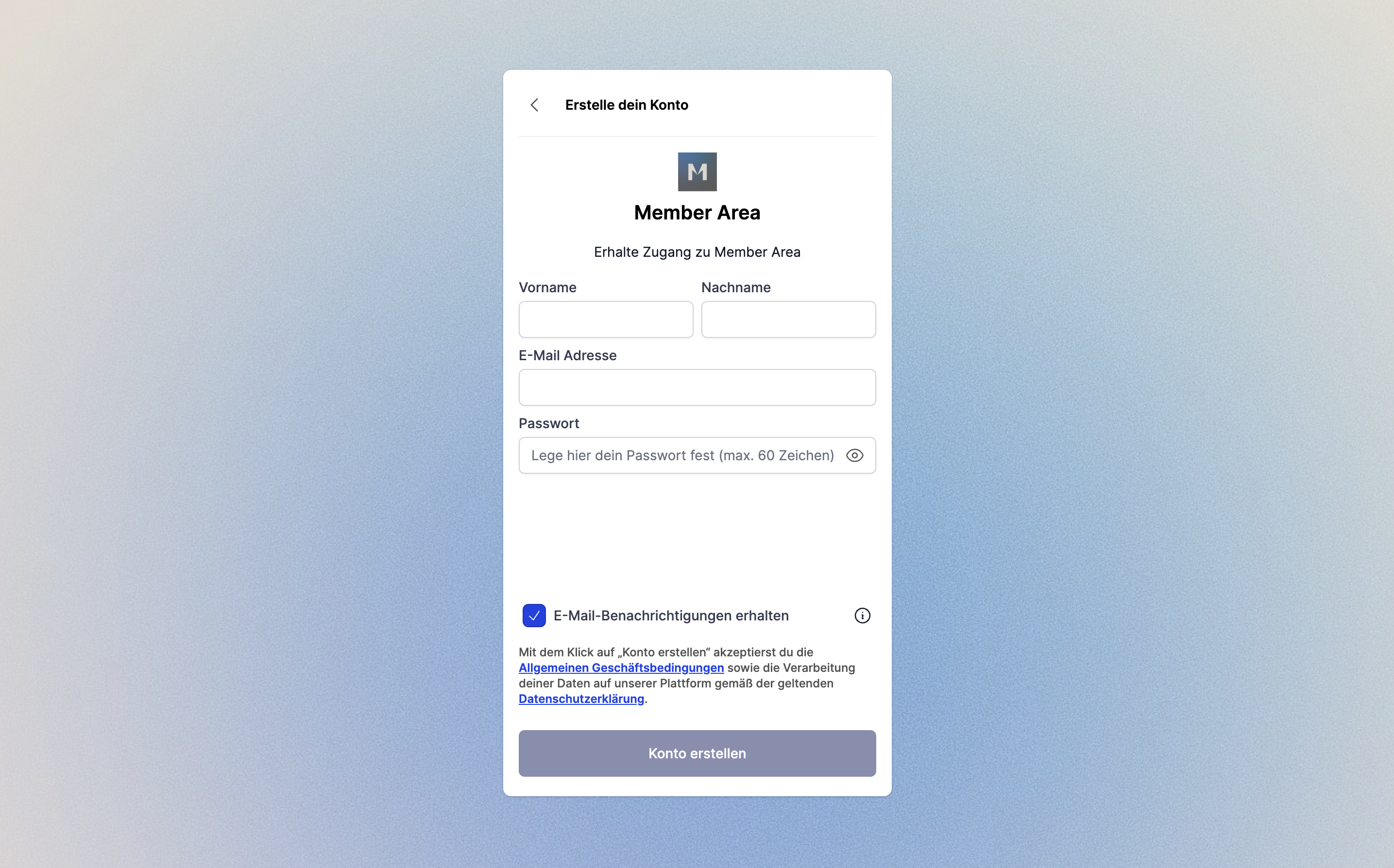
Create the right pricing strategy for your online course
The most common option when selling online courses is the one-off payment. Here you set a fixed price that members pay for full access to the course. Subscriptions are only interesting for you if you regularly offer your customers exclusive content.
If you're not aiming for big money, you can start by selling your online courses so cheaply that your profit and loss are zero. This strategy makes sense if you are just starting out in the online course business and want to build up a community. Once you have gained the trust of your customers, you can build on this and offer further courses or coaching sessions at higher prices.
The right payment providers
At the latest when your course is ready and you have decided against an all-in-one platform, you need to look around for a suitable payment provider. Important: This provider should be based in Germany so that you are legally compliant and GDPR-compliant. Providers with reseller models take a large part of the bookkeeping off your hands, giving you valuable time that you can invest in new projects.
DigiStore24 is one of the most popular payment providers for online courses in German-speaking countries. You can sell your digital online courses on DigiStore24's huge marketplace. Each product sold incurs a fee of 7.9% of the selling price plus 1 euro. If you don't sell anything, you don't pay anything.
CopeCart works on the same principle as DigiStore24 - but has significantly lower transaction fees at 4.9 % plus 1 euro. Furthermore, you can start selling straight away. Verification only takes place afterwards.
Common payment methods such as PayPal, SEPA direct debit, credit card or instant bank transfer are possible with both resellers.
With Memberspot, it's very easy to connect to payment providers such as CopeCart or DigiStore24. You can also connect apps such as Paypal or Stripe to the popular Zapier web service and automate them in this way.
In this article we will show you step by step how to use Zapier to connect PayPal. However, this also works in exactly the same way for other providers
Easily connect Memberspot to payment providers and other tools
Once you have reached this point, congratulations, you have created your own online course!
Would you like to know more or are you curious about Memberspot? Then email or write to us via the live chat and we'll be there for you.






